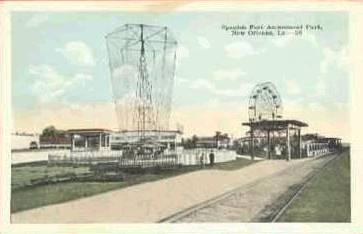Smokey Mary
Sun Mar 16 02:57:03 2003
The Smokey Mary made its last run to the Lake in 1932--71 years ago.
I'd
guess a person would have to be around 80 years old to remember the Smokey Mary.
I remember the old timers talking about it. I'll have to remember to ask my
grandmother and father-in-law about their recollections. I know LakeviewGal will
ask her Dad. Hey Alert--ask your parents. Everybody else--if you have an N.O.
connection who might remember the old Smokey Mary please ask them about it and
let us know what they say. Sad to say, it won't be very long until there isn't
anyone around who remembers it.

a
1920s Spanish Fort Postcard -- The railroad tracks are presumably for the
"Smokey Mary".
From what I can find the Smokey Mary at one time was part of the street car
system. Nopsi (N.O. Public Service) claims the Smokey Mary on their (probably
now defunct) website as one of their own. To my knowledge, electric street cars
were utilized during the 1930s when the last ride was offered.
Here's more:
Because of the large influx of nonresidents in the French
Quarter, New Orleans’ first transportation system was started.
The fare
in 1832 was 12 1/2 cents. The service began with two small, horse-drawn
vehicles. The line ran from Canal to Chartres, down Chartres to Jackson Square,
then to the cotton presses on Levee Street.
From there it went to the
Pontchartrain Railroad depot, located near the river on Elysian Fields Avenue.
In a very short time, the service was overloaded, due to the vehicles’ limited
carrying capacity.
The owners of the line resolved the problem almost
immediately. The Louisiana Advertiser newspaper ran an article stating that the
two small omnibuses were to be replaced. The new vehicles, built by Messrs.
Carter of New York, arrived in New Orleans and were hastily put into service on
Dec. 19, 1832.
The name given the two were “Cotton Plant” and “Tobacco
Plant.” Each carried 14 passengers, comfortably seated, and they were each
pulled by four horses. Service began at 7 a.m. and stopped at 7:30 p.m. As an
additional service to their customers, the omnibuses also carried letter boxes.
For the comfort of its female passengers, a sign in each carriage requested that
gentlemen not smoke.
Source: Buddy Stall at http://clarionherald.org/20010927/stall.htm
1830
charter at http://www.stphilipneri.org/teacher/pontchartrain/content.php?type=4&id=506
Mark
Twain references at http://www.stphilipneri.org/teacher/pontchartrain/content.php?type=4&id=197
and http://www.stphilipneri.org/teacher/pontchartrain/content.php?type=4&id=263
1910
station at Spanish Fort--http://www.stphilipneri.org/teacher/pontchartrain/content.php?type=4&id=436
A
1914 schedule at http://www.stphilipneri.org/teacher/pontchartrain/content.php?type=4&id=158
and a 1922 schedule at http://www.stphilipneri.org/teacher/pontchartrain/content.php?type=4&id=509
The
End--1935 at http://www.stphilipneri.org/teacher/pontchartrain/content.php?type=4&id=508
And more at http://www.stphilipneri.org/teacher/pontchartrain/content.php?type=1&id=243
Mr.
Lake
~~~~~~~~~~~~~~
From a website at: http://www.maisonmario.com/words/lagniappe/marigny.html we
find, "The Pontchartrain Railroad, the first railroad West of the Alleghenies
(and second oldest in the country), was completed in 1831 running along Elysian
Fields from the river to the resort area at Milneburg on Lake Pontchartrain. The
line was nick named "Smoky Mary" because the train was fuelled by coal which
belched smoke and left a sooty residue in its path. The rail was later converted
to electric but was discontinued and the tracks removed in the
1950's".
Then from: http://community-2.webtv.net/bulletbob52/ArticlesOfInterest/
"The first trains were pulled by horses. The Pontchartrain line did not put a
locomotive into service until 1832".
In Harnett T. Kane's "Queen New
Orleans, City by the River", 1949, Wm. Morrow & Co., N.Y., N.Y., Chapter 7,
page 131, "....the Pontchartrain Railroad, finished at last, was four and a half
miles long--the first in the South, the first West of the Alleghenies; and the
only one, I think, to be equipped with sails as auxiliary power! For when the
steam engine gave trouble or actually failed, which was often, the engineers put
up sails and the wind sent the locomotive skimming along. New orleans called it
'Smoky Mary' and the line remained in uninterrupted existence probably longer
than any other in America, a hundred and two years."
I recall riding the St. Charles line to Dr.'s appointments near Touro or
Loyola Field House events and observing people meeting the cars along the route
and reaching in and placing packages on the conductors' platforms. Later during
the trip, other folks would meet the trolleys and reach in and retrieve the
packages. These included bundles of newspapers (dropped off at news stands along
the way), prescriptions, bags of groceries, other goodies! Not a dime was
observed changing hands (nor was .07 cents, the car fare back then) during these
operations.
CopCop
~~~~~~~~~~~~~~~~~~
Yeah, my dad remembers...I
know he's mentioned that because the windows were open you'd often get cinders
in your eyes from the smoking engine. I'll see if he has any other
recollections.
LakeviewGal

